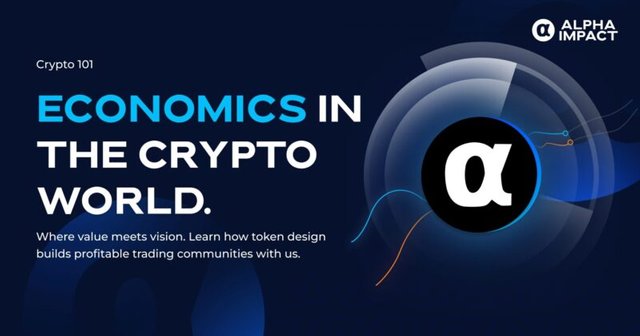Tokenomics vs. Crypto-Economics: Understanding The Foundation of Digital Assets

Ever wondered why some cryptocurrencies are worth thousands while others barely scratch a penny? The answer lies in their economic design — what we call tokenomics vs. crypto-economics.
Tokenomics refers to the economic model and principles that govern a cryptocurrency, including its supply, distribution, utility, and incentives. On the other hand, crypto-economics is a broader concept that encompasses the study of how economic systems and incentives are designed within blockchain networks to ensure security, decentralization, and functionality.
Today, we’re breaking down how our utility token, , works at the core of our platform’s economy and why its design matters for experienced and new traders.
What Makes a Token Valuable?
Think of tokenomics as the economic rules of a small country. Just as a country’s economy depends on its money supply and what you can buy with it, a token’s value comes down to some basic factors:
Total and Circulating Supply: How many tokens exist and will exist, and whether this supply increases (inflationary) or decreases (deflationary) over time
Practical Utility: The token’s applications within its ecosystem (e.g., payments, rewards, governance, staking).
Distribution Model: Who owns what and when they can sell tokens?
A Real-World Example: FOLO’s Deflationary Model
The number of tokens in circulation plays a huge role in their value. Take Bitcoin, with its famous cap of 21 million coins, versus tokens that mint billions of units. But this isn’t just about who has the largest numbers — it’s about understanding how supply changes over time.
Like many crypto projects, FOLO started with a clear plan for its token supply — capped at 424 million tokens, released gradually over four years. But here’s where it gets interesting: to maintain value stability, we burn 3 million tokens every month, permanently removing them from circulation. This deflationary mechanism helps protect long-term token value while supporting sustainable growth.
Utility Across User Groups
A token needs real utility, or it’s just digital numbers. FOLO shows how this works in practice:
For experienced traders:
- Monetise trading expertise through subscription-based content
- Set custom subscription rates with payments in FOLO or USDT
- Stake tokens to enhance platform visibility
- Share verified portfolio analytics behind paywalls
For new traders:
- Access verified trading expertise
- Copy trades automatically from top performers
- Support valuable content creators and foster a knowledge-sharing community
- View authenticated portfolio performance
Distribution: The Hidden Factor
Even great tokenomics can fail with poor distribution. As of early 2025, Alpha Impact maintains a conservative approach to FOLO’s token distribution . Currently, less than 20% of the total supply circulates in the market, creating natural scarcity while preserving growth potential.
This matters because when you invest in a token, you’re not just buying what exists today — you’re buying into its future supply too. A token’s current market cap might look attractive, but you need to consider its fully diluted value — what would the market cap be if all possible tokens were in circulation?
Let’s break this down with a simple example:
- If a token has 1 million coins trading at $1 today (current market cap = $1 million)
- But will have 10 million coins eventually (fully diluted value = $10 million)
- The project needs 10x more buying pressure just to maintain that $1 price once all tokens are released
Alpha Impact makes its token distribution data available in real-time through their platform, letting investors see exactly how tokens are distributed and when they might enter circulation. This level of openness helps investors make more informed decisions about their investment timeline and potential dilution risks.
Crypto-Economics: The Bigger Picture
Tokenomics vs. Crypto-Economics: While tokenomics looks at individual tokens, crypto-economics analyzes the broader blockchain ecosystem. Think of it as the difference between studying one company’s stock versus understanding how the whole stock market works.
Good crypto-economics answers three big questions:
- How do we get people to maintain a network without central control?
- What makes a blockchain secure and sustainable?
- How do we align everyone’s interests without traditional management?
The answers usually involve:
Decentralized Governance: Just as shareholders vote on company decisions, token holders can vote on project changes. But in crypto, these votes often execute automatically through smart contracts.
Trustless Transactions: Instead of relying on banks or brokers, crypto uses economic incentives to keep things running.
Economic Incentives: Good projects create virtuous cycles. In FOLO’s case, experienced traders earn more by helping newcomers succeed, while new traders get access to verified expertise. Everyone wins by making the system work better.
Conclusion
The best projects succeed on both levels — good tokenomics for their individual token, and smart crypto-economic design for their broader ecosystem. After all, even the best token design needs a healthy ecosystem to thrive in.
FOLO’s strength lies in its dual foundation: robust tokenomics paired with thoughtful ecosystem design. This creates a virtuous cycle where every participant’s success strengthens the whole network. Experienced traders earn more by sharing their expertise, new traders gain access to proven strategies, and the entire community grows stronger together.
Ready to join the Alpha Impact ecosystem?
About Alpha Impact
Alpha Impact is a non-custodial, technology platform building social infrastructure and integrates with Interoperable Real-World Signals.
Our Interoperable platform provides real-time trade signals, comprehensive cross-exchange portfolio analytics, risk management, and copy trading. This empowers signal providers to monetise their expertise and actionable insights through a social community.